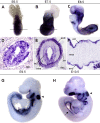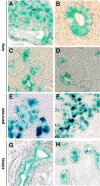Genetic targeting of the endoderm with claudin-6CreER
- PMID: 18213590
- PMCID: PMC2665265
- DOI: 10.1002/dvdy.21437
Genetic targeting of the endoderm with claudin-6CreER
Abstract
A full description of the ontogeny of the beta cell would guide efforts to generate beta cells from embryonic stem cells (ESCs). The first step requires an understanding of definitive endoderm: the genes and signals responsible for its specification, proliferation, and patterning. This report describes a global marker of definitive endoderm, Claudin-6 (Cldn6). We report its expression in early development with particular attention to definitive endoderm derivatives. To create a genetic system to drive gene expression throughout the definitive endoderm with both spatial and temporal control, we target the endogenous locus with an inducible Cre recombinase (Cre-ER(T2)) cassette. Cldn6 null mice are viable and fertile with no obvious phenotypic abnormalities. We also report a lineage analysis of the fate of Cldn6-expressing embryonic cells, which is relevant to the development of the pancreas, lung, and liver.
Figures





References
-
- Ang SL, Rossant J. HNF-3β is essential for node and notochord formation in mouse development. Cell. 1994;78:561–574. - PubMed
-
- Apelqvist A, Ahlgren U, Edlund H. Sonic hedgehog directs specialised mesoderm differentiation in the intestine and pancreas. Curr Biol. 1997;7:801–804. - PubMed
-
- Batlle E, Sancho E, Francí C, Domínguez D, Monfar M, Baulida J, García de Herreros A. The transcription factor snail is a repressor of E-cadherin gene expression in epithelial tumour cells. Nat Cell Biol. 2000;2:84–89. - PubMed
-
- Belo JA, Bachiller D, Agius E, Kemp C, Borges AC, Marques S, Piccolo S, De Robertis EM. Cerberus-like is a secreted BMP and nodal antagonist not essential for mouse development. Genesis. 2000;26:265–270. - PubMed
Publication types
MeSH terms
Substances
Grants and funding
LinkOut - more resources
Full Text Sources
Other Literature Sources
Molecular Biology Databases
Research Materials

